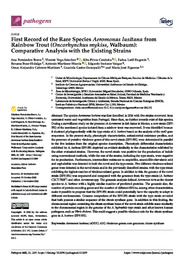Title:
First Record of the Rare Species Aeromonas lusitana from Rainbow Trout (Oncorhynchus mykiss, Walbaum): Comparative Analysis with the Existing Strains |
Authors:
Fernández-Bravo, Ana 
Vega Sánchez, Vicente 
Pérez-Cataluña, Alba 
Latif-Eugenin, Fadua
Beaz-Hidalgo, Roxana
Martínez-Murcia, Antonio
Soriano-Vargas, Edgardo 
Cabrero-Martínez, Omar Alejandro 
CASTRO-ESCARPULLI, GRACIELA 
Figueras, María José |
Editor:
MDPI |
Department:
Departamentos de la UMH::Producción Vegetal y Microbiología |
Issue Date:
2022-11-05 |
URI:
https://hdl.handle.net/11000/35096 |
Abstract:
The species Aeromonas lusitana was first described in 2016 with five strains recovered from untreated water and vegetables from Portugal. Since then, no further records exist of this species. During a surveillance study on the presence of Aeromonas in fish farms in Mexico, a new strain (ESV-351) of the mentioned species isolated from a rainbow trout was recovered. It was identified because it clustered phylogenetically with the type strain of A. lusitana based on the analysis of the rpoD gene sequences. In the present study, phenotypic characteristics, antimicrobial resistance profiles, and the presence of putative virulence genes of this novel strain (ESV-351) were determined in parallel to the five isolates from the original species description. Phenotypic differential characteristics exhibited by A. lusitana ESV-351 depicted an evident similarity to the characteristics exhibited by the other evaluated strains. However, the novel strain was positive for the production of indole using conventional methods, while the rest of the strains, including the type strain, were negative for its production. Furthermore, intermediate resistance to ampicillin, amoxicillin-clavulanic acid and cephalothin was detected in both the novel and the type strain. Five different virulence-related genes were detected in the novel strain and in the previously described strains, with the type strain exhibiting the highest number of virulence-related genes. In addition to this, the genome of the novel strain (ESV-351) was sequenced and compared with the genomes from the type strain (A. lusitana CECT 7828T) and other Aeromonas spp. The genomic analysis defined Aeromonas tecta as the closest species to A. lusitana with a highly similar number of predicted proteins. The genomic size, the number of protein-encoding genes and the number of different tRNAs, among other characteristics, make it possible to propose that the ESV-351 strain could potentially have the capacity to adapt to different environments. Genome comparison of the ESV-351 strain with the type strain revealed that both possess a similar sequence of the citrate synthase gene. In addition to this finding, the chromosomal region containing the citrate synthase locus of the novel strain exhibits some similarity to the chromosomal region in the genome of the A. hydrophila type strain and other known human pathogens, such as Vibrio cholerae. This could suggest a possible virulence role for the citrate synthase gene in A. lusitana (ESV-351)
|
Keywords/Subjects:
Aeromonas lusitana
isDDH
ANI
Virulence genes
Core genomes
Citrate synthase |
Type of document:
info:eu-repo/semantics/article |
Access rights:
info:eu-repo/semantics/openAccess
Attribution-NonCommercial-NoDerivatives 4.0 Internacional |
DOI:
https://doi.org/10.3390/pathogens11111299 |
Published in:
Pathogens 2022, 11(11), 1299 |
Appears in Collections:
Artículos - Producción vegetal y microbiología
|

.png)
